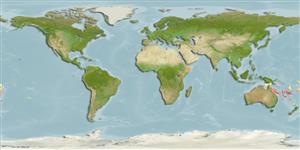Common names from other countries
Classification / Names / Names
Common names | Synonyms | Catalog of Fishes (gen., sp.) | ITIS | CoL | WoRMS
Environment: milieu / climate zone / depth range / distribution range
Ecology
Benthic; depth range 15 - 183 m (Ref. 89006). Temperate
Southern Pacific: New Caledonia, Lord Howe Island, and Kermadec Islands.
Length at first maturity / Size / Weight / Age
Maturity: Lm ? range ? - ? cm
Minimum depth from Ref. 8121. Found attached to algae and cnidarians at 15 to 60 m while dead specimens could be found at depths down to 420 m (Ref. 377).
Life cycle and mating behavior
Maturity | Reproduction | Spawning | Eggs | Fecundity | Larvae
Members of the class Bivalvia are mostly gonochoric, some are protandric hermaphrodites. Life cycle: Embryos develop into free-swimming trocophore larvae, succeeded by the bivalve veliger, resembling a miniature clam.
Spurgeon, A. 2007. (Ref. 8121)
IUCN Red List Status (Ref. 130435)
CITES status (Ref. 108899)
Not Evaluated
Not Evaluated
Human uses
| FishSource |
Tools
More information
Age/Size
Growth
Length-weight
Length-length
Morphology
Larvae
Abundance
Internet sources
Estimates based on models
Preferred temperature
(Ref.
115969): 23.7 - 24.5, mean 24.3 (based on 5 cells).
